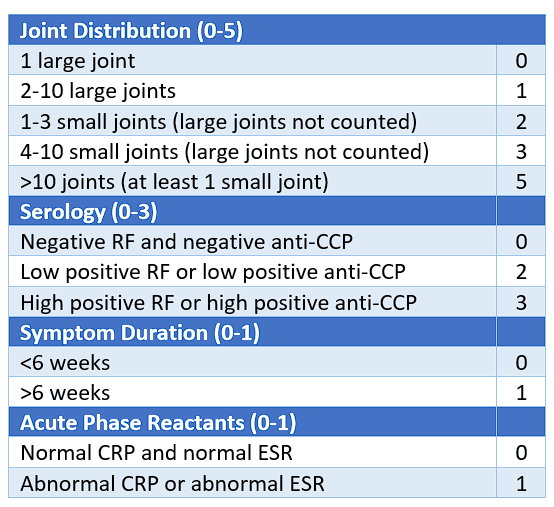Next Lesson - Systemic Lupus Erythematosus
Abstract
- Rheumatoid arthritis is an autoimmune inflammatory disease with systemic features typically affecting the small joints.
- Rheumatoid arthritis and osteoarthritis can be differentiated based on the joints affected, symmetry of the disease, pathophysiology, and radiological features.
- Diagnosis of rheumatoid arthritis can be confidently made with a score higher than 6 on the 2010 ACR/EULAR classification criteria.
- Gold standard management of RA comprises dual therapy of DMARDs and steroids.
- Complications associated with RA include carpal tunnel syndrome, Felty’s syndrome and increased risks of cardiovascular disease.
- Other complications can be related to drugs used in the management of RA and patients should be regularly monitored for neutropenic sepsis.
Core
Rheumatoid arthritis (RA) is an autoimmune inflammatory disease with systemic features typically presenting with symmetrical joint deformities. It is believed to be caused by a combination of genetic and environmental factors and is a relatively common condition with a prevalence of 1% of the UK population, with an increased occurrence in females compared to males of about 2:1. It often manifests in adulthood (generally >40 years) but can happen at an earlier onset in some cases (source).
The textbook presentation of rheumatoid arthritis can be memorised as the 3 S's:
- Stiffness – usually reported as early morning stiffness lasting for over 30 minutes
- Swelling – persistent joint swelling, commonly in the hands
- Squeezing – squeezing of the joints during examination is usually painful
An important differential to exclude when making a diagnosis of rheumatoid arthritis is osteoarthritis (OA). Here are some key characteristics of each to help differentiate between the two:

Table - The symptomatic differences between rheumatoid arthritis and osteoarthritis
RA and OA can also be differentiated by characteristic radiological features. Features of RA can be remembered as LESS, and those of OA can be remembered as LOSS.

Table - The differentiating radiological features between rheumatoid arthritis and osteoarthritis
If left untreated, RA can lead to severe joint deformities, but these are much rarer nowadays with the advent of treatment therapies. These can be remembered by the following mnemonic: BUS Z.
- Boutonnière Deformity – proximal inter-phalangeal joint (PIP) flexion and distal interphalangeal joint (DIP) hyperextension
- Ulnar Deviation – subluxation of the wrist and fingers due to swollen metacarpal-phalangeal joints (MCPs)
- Swan-neck Deformity – proximal interphalangeal joint (PIP) hyperextension and distal interphalangeal joint (DIP) flexion
- Z-thumb – interphalangeal joint (IP) flexion and metacarpal-phalangeal joint (MCP) hyperextension leading to squaring of the thumb
Routine tests to consider for a patient suspected to have RA should include:
- Full Blood Count (FBC) – which could show signs of anaemia of chronic disease and elevated platelet count as thrombocytosis is a complication of RA.
- C-reactive Protein (CRP) – which can be elevated as it is a marker of inflammation although it can be within the normal range in up to 60% of rheumatoid arthritis patients.
- Erythrocyte Sedimentation Rate (ESR) – which can be elevated in proportion to the level of inflammation.
- Liver and kidney function tests (LFTs & U&Es) can also be requested to help choice of management options.
Routine imaging is usually X-ray although ultrasound scan and MRI are more sensitive to bony erosions but not as commonly used due to cost-effectiveness.
Specific autoantibodies related to RA to include in investigations to aid diagnosis are the following:
- Rheumatoid Factor (RF) – it is positive in about 70% of cases and increased levels correlate with disease severity.
- Anti-cyclic Citrullinated Peptide (anti-CCP) – this is the most specific (98%) test for RA with a high sensitivity (70-80%) too.
The 2010 ACR/EULAR classification criteria for RA is a useful tool to confirm a diagnosis of RA. A score above 6 is diagnostic of rheumatoid arthritis.

Table - Criteria for the ACR/EULAR Classification Criteria for RA. A score of above 6 is diagnostic for RA
Initial management is usually provided in secondary care following a rheumatology referral. Rheumatologists should perform a thorough examination of the joints and quantify the disease severity with the DAS28 (disease activity score), which assesses 28 different joints commonly affected in RA.
The gold standard treatment of RA is a combination therapy using both disease-modifying anti-rheumatic drugs (DMARDs) and steroids. Early use of DMARDs can improve disease outcomes and prevent progression of the disease. These should be ideally started within 3 months of symptoms and can take 6 to 12 weeks to produce noticeable effects.
Commonly prescribed agents include methotrexate, hydroxychloroquine, sulfasalazine and leflunomide. The use of steroids is recommended to help reduce inflammation and alleviate symptoms, but due to the complications of long-term steroid use, these are ideally only to be used in acute flare-ups. Prednisolone or methylprednisolone are the steroid agents of choice in RA.
Importantly, patients should be informed of the immunosuppressive side effect of these drugs and subsequent increased susceptibility to infection, and require regular monitoring of their FBC and LFTs to screen for neutropenia (low neutrophil count) or inflammation of the liver caused by the drugs.
Other conservative measures to be provided in combination with pharmacological management are specialist physio and occupational therapies to help patients improve their quality of life and minimize the disease impact. Smoking cessation should also be recommended and encouraged as smoking can worsen symptoms in RA.
Finally, surgery might be required in advanced cases or to relieve common complications such as carpal tunnel syndrome.
The systemic nature of the inflammation in RA can lead to a range of complications. In the wrist, swelling of the joint space can lead to carpal tunnel syndrome and vascular inflammation can cause Raynaud’s phenomenon in the hands. On the skin, RA can manifest through rheumatoid nodules. Patients with RA also have an increased risk of cardiovascular disease as well as pericarditis and parenchymal lung disease, to name a few.
A rarer but serious complication of RA to look for is Felty’s syndrome which is characterised by a triad of rheumatoid arthritis, splenomegaly and neutropenia which puts patients at high risk of recurrent infections.
Other complications can also be associated with side effects of the drugs used in the management of rheumatoid arthritis.
Edited by: Dr. Maddie Swannack
Reviewed by: Dr. Thomas Burnell
- 2993

